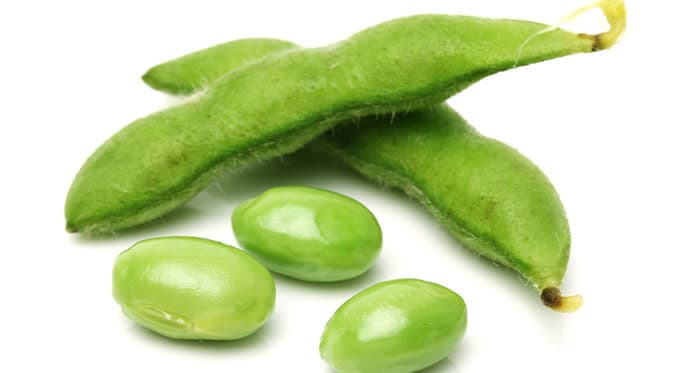Soy: The Versatile Plant-Based Protein Source

In recent years, you may have heard a lot of conflicting information about soy and soy-based products. And there are good reasons for that. First, soy is both a straight-from-the-ground food (i.e., soybeans), and a heavily refined food (e.g., protein powder), depending on what form you eat it in. Next, there is much nutrition science interest around soy and cancer. Whenever there is a lot of interest, there’s a lot of research; whenever there’s a lot of research, there’s new information. That’s the nature of science – it changes over time, as we learn more.
Soy first came to the US in the 18th century. It migrated from Southeast Asia, where it had been a dietary staple for over 2000 years. The combination of advances in food processing and soy’s affordability to grow seem to have deposited soy everywhere in the modern American diet: meat substitutes, soy milk, soybean oil, frozen dessert, soy sauce, miso, soy nuts for snacks, and more.
Soybeans are legumes, a class of foods that in and of itself has multiple health benefits; it is also one of the only plant-based complete proteins, making it a 1-1 substitute for meat (more on both of those later). Although you may be most familiar with tofu, the most minimally processed forms of soy are edamame and tempeh, both of which are included in the challenge.
Tofu –Tofu is low in calories and high in protein. It’s easy to find in the supermarket and can be prepared many ways: baked, sautéed, or even blended with fresh or frozen fruit (bonus if you add a handful of spinach!) for a dairy-free smoothie. Tofu is, however, a processed food – the beans are ground, heated, and coagulated into a white curd.
Edamame – The whole soybean, available in whole pods or shelled. From the pod, they’re a tasty snack: boil them very briefly in lightly salted water. If you buy the shelled version, sprinkle them on a green salad to add some protein, or make them more of a centerpiece in a bean-and-vegetable salad.
Tempeh – A fermented version of soy. It has a more solid texture, meatier flavor, and more fiber than tofu. You also get the benefits of a fermented food: most of the microbes don’t make it through your stomach alive, but even dead microbes support the living “good” bacteria already in your gut. Try it thinly sliced with veggies in a stir-fry.
All these forms of soy have many health benefits. As a legume, it’s high in fiber and a good source of essential minerals. Although soy has more fat than other legumes, most of the fat is unsaturated and thus not associated with inflammation. Unlike many other plant proteins and legumes (like black beans or lentils), soy contains all essential amino acids to make a “complete” protein. But possibly the most unique thing about soy are its naturally-occurring phytonutrients called isoflavones; the two found in largest amounts are called genistein and daidzein. Researchers are interested in these for their anti-inflammatory and antioxidant activity.
Now, you may have heard about soy as related to breast and prostate cancer, because these are both hormone-driven cancers. Isoflavones’ chemical structure is similar to estrogen, so there was the thought that they can weakly interact with estrogen receptors—sometimes acting like estrogen, and sometimes blocking estrogen. This has raised concern about soy potentially causing or worsening hormone-related cancers such as breast or endometrial cancer. It sounds logical: if a woman’s breast cancer is fueled by estrogen, soy is bad, right? Actually, no—it’s more complicated. Isoflavones have different effects in different tissues and in different people. Soy does not appear to increase risk of breast cancer, and some studies have shown a benefit in prostate cancer. Research continues to define the effects of soy (specifically, the isoflavones) in cancer. If anything, there is a beneficial, or neutral, effect.
As referred to earlier, some of the confusing information on soy out there has to do with its multiple forms—whole soy (edamame or tofu), fermented (tempeh), or as a protein supplement. To complicate matters further, the people that scientists study also matter. For example, researchers tend to see greater benefits in Asian cultures; this may be because soy is eaten in relatively larger amounts throughout life, or it may be due to other factors in the Asian diet. It’s hard to get enough information one way or the other on US populations because we generally eat so little soy.
The reasons soy is recommended for prostate cancer patients is complex, and it has to do with overall lowering of disease risk. Men with prostate cancer often have risks for other conditions—such as high blood pressure, high cholesterol, weight gain over the years leading to increased risk of type 2 diabetes—all associated with increased risk for heart disease. Eating soy as part of a healthy diet, and replacing some red meat, is a strategy for maintaining a healthy weight. Eating less saturated fat (such as that in animal products) is associated with less inflammation, which is implicated in accelerating many chronic diseases.
Ultimately, the benefits of soy may lie in the substitution for other, less-healthy, sources of protein. That soy-based burger may be processed, but it has more fiber and less saturated fat and calories than a cheeseburger. If you substitute tempeh for flank steak in your stir-fry, even better. By eating whole soy, you get the known benefits of fiber and plant-based protein, as well as isoflavones—which appear to be beneficial and are still under study.
Do you have a creative way that you prepare tofu, tempeh or soybeans? Post it here for all to enjoy: 30 Foods in 30 Days.









